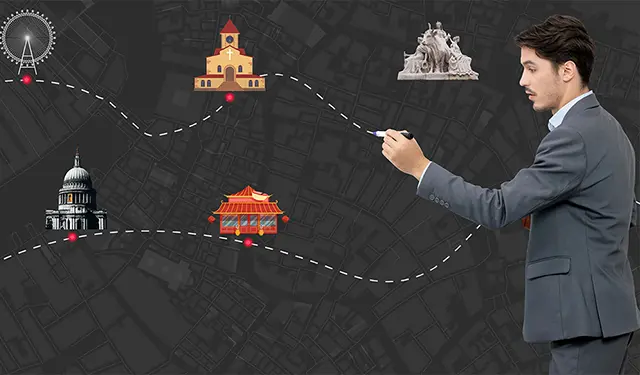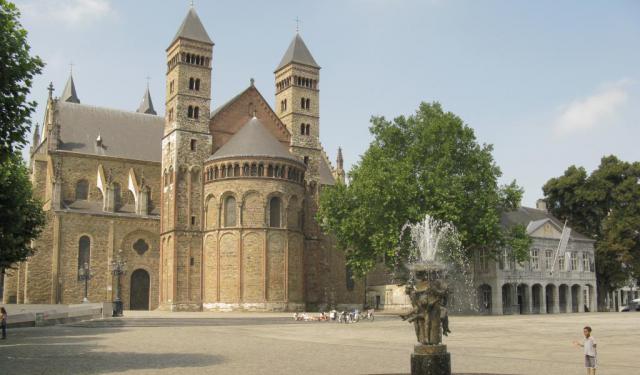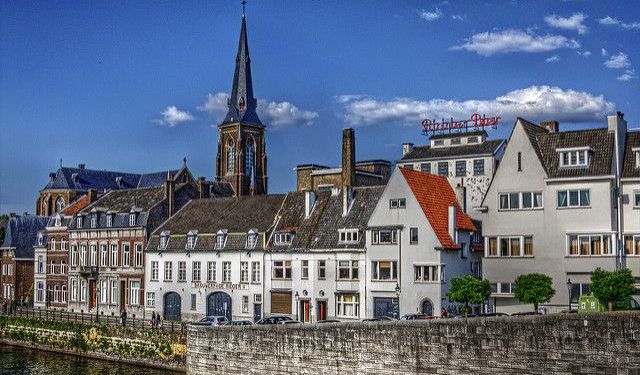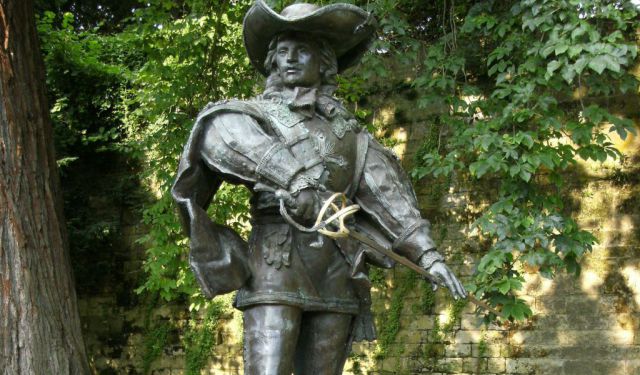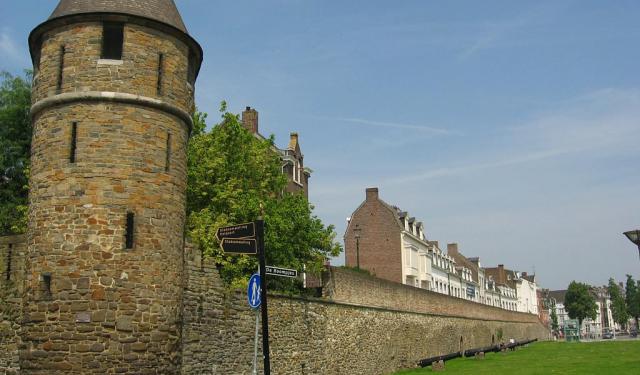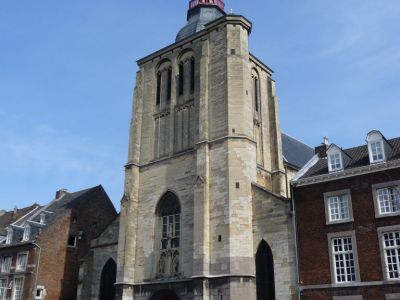
Sint-Matthiaskerk (St. Matthias Church), Maastricht
The Saint Matthias Church is a Gothic church in the heart of Maastricht. As one of the four Roman Catholic parish churches in the city center, it is dedicated to the apostle Matthias. Behind the church, a former cemetery later became a parsonage garden, bordered by the Saint Anthony Chapel.
The foundation stone of the current church was laid in 1351, but records indicate a church existed on this site as early as 1297-98. Built in Maas Gothic style, Saint Matthias Church features a three-aisled marl stone structure atop a Namur stone plinth. Its unfinished three-section tower, with a stair turret on the southwest, is slightly misaligned with the main axis. The 1769 tower crown complements the west entrance, set beneath a neo-Gothic Calvary sculpture from 1882. The basilical nave has a higher choir, a sacristy to the north, and a neo-Gothic baptistery from 1859 to the south.
Inside, the church features a six-bay nave, a two-bay high chancel, and lower aisles. Irregular columns with varied capitals, some Maas-style, separate the aisles from the nave. Vault ribs rest on carved consoles depicting angels and coats of arms. The ground floor of the tower serves as the entrance, with a 1680 Baroque porch from the Augustinian church. The pentagonal choir has Gothic windows, while the marble folk altar comes from the demolished Third Franciscan Church. Notable furnishings include a Louis XIV pulpit, a 1707 baptismal font from the Catharina Chapel, and a circa 1300 baptismal font now in the Bonnefantenmuseum.
The church preserves late Gothic paintings, including a Resurrection from 1585 in the north aisle. While a 19th-century neo-Gothic decorative scheme once adorned the interior, much of it was covered by plaster and marble slabs in the 1920s. The stained glass windows mostly date to the 19th century, with some later additions by Charles Eyck.
Among the church’s significant artworks are several late Gothic statues, including a 15th-century Pietà and a female saint attributed to Jan van Steffeswert. The church’s treasury holds an extensive collection of reliquaries, chalices, monstrances, and other liturgical vessels, as well as a rare collection of 18th- and 19th-century silver brotherhood plaques.
The foundation stone of the current church was laid in 1351, but records indicate a church existed on this site as early as 1297-98. Built in Maas Gothic style, Saint Matthias Church features a three-aisled marl stone structure atop a Namur stone plinth. Its unfinished three-section tower, with a stair turret on the southwest, is slightly misaligned with the main axis. The 1769 tower crown complements the west entrance, set beneath a neo-Gothic Calvary sculpture from 1882. The basilical nave has a higher choir, a sacristy to the north, and a neo-Gothic baptistery from 1859 to the south.
Inside, the church features a six-bay nave, a two-bay high chancel, and lower aisles. Irregular columns with varied capitals, some Maas-style, separate the aisles from the nave. Vault ribs rest on carved consoles depicting angels and coats of arms. The ground floor of the tower serves as the entrance, with a 1680 Baroque porch from the Augustinian church. The pentagonal choir has Gothic windows, while the marble folk altar comes from the demolished Third Franciscan Church. Notable furnishings include a Louis XIV pulpit, a 1707 baptismal font from the Catharina Chapel, and a circa 1300 baptismal font now in the Bonnefantenmuseum.
The church preserves late Gothic paintings, including a Resurrection from 1585 in the north aisle. While a 19th-century neo-Gothic decorative scheme once adorned the interior, much of it was covered by plaster and marble slabs in the 1920s. The stained glass windows mostly date to the 19th century, with some later additions by Charles Eyck.
Among the church’s significant artworks are several late Gothic statues, including a 15th-century Pietà and a female saint attributed to Jan van Steffeswert. The church’s treasury holds an extensive collection of reliquaries, chalices, monstrances, and other liturgical vessels, as well as a rare collection of 18th- and 19th-century silver brotherhood plaques.
Want to visit this sight? Check out these Self-Guided Walking Tours in Maastricht. Alternatively, you can download the mobile app "GPSmyCity: Walks in 1K+ Cities" from Apple App Store or Google Play Store. The app turns your mobile device to a personal tour guide and it works offline, so no data plan is needed when traveling abroad.
Sint-Matthiaskerk (St. Matthias Church) on Map
Sight Name: Sint-Matthiaskerk (St. Matthias Church)
Sight Location: Maastricht, Netherlands (See walking tours in Maastricht)
Sight Type: Religious
Guide(s) Containing This Sight:
Sight Location: Maastricht, Netherlands (See walking tours in Maastricht)
Sight Type: Religious
Guide(s) Containing This Sight:
Walking Tours in Maastricht, Netherlands
Create Your Own Walk in Maastricht
Creating your own self-guided walk in Maastricht is easy and fun. Choose the city attractions that you want to see and a walk route map will be created just for you. You can even set your hotel as the start point of the walk.
Maastricht's Historical Buildings Walking Tour
Founded by the Romans some 2,000 years ago, the charming city of Maastricht is one of the oldest in the Netherlands. Its long history is manifested in numerous remnants, including religious and secular buildings of any form. Over the course of the centuries, Maastricht has garnered a wealth of architecture, featuring a variety of styles: Gothic, Baroque, Romanesque and Renaissance.
Cultural... view more
Tour Duration: 2 Hour(s)
Travel Distance: 3.1 Km or 1.9 Miles
Cultural... view more
Tour Duration: 2 Hour(s)
Travel Distance: 3.1 Km or 1.9 Miles
Maastricht Introduction Walking Tour
Maastricht is an ancient city known for its rich history, medieval architecture, and vibrant cultural scene.
In the first century AD, the Romans built a bridge across the Meuse river. A settlement grew near the bridge. Maastricht's name means "a place to cross the Meuse river". Today, a pillar marks this location of the original Roman bridge.
The Roman settlement was small,... view more
Tour Duration: 2 Hour(s)
Travel Distance: 2.2 Km or 1.4 Miles
In the first century AD, the Romans built a bridge across the Meuse river. A settlement grew near the bridge. Maastricht's name means "a place to cross the Meuse river". Today, a pillar marks this location of the original Roman bridge.
The Roman settlement was small,... view more
Tour Duration: 2 Hour(s)
Travel Distance: 2.2 Km or 1.4 Miles
Statues and Monuments Tour
The citizens of Maastricht are reputed to be spiritual and have a good sense of humor. Their attitude towards life, as well as their customs and traditions, are vividly reflected in the numerous statues and monuments scattered throughout the city.
Among these is the Statue of Jan Pieter Minckeleers, commemorating the local inventor of gas lighting. Another notable figure is the Mooswief, also... view more
Tour Duration: 1 Hour(s)
Travel Distance: 2.1 Km or 1.3 Miles
Among these is the Statue of Jan Pieter Minckeleers, commemorating the local inventor of gas lighting. Another notable figure is the Mooswief, also... view more
Tour Duration: 1 Hour(s)
Travel Distance: 2.1 Km or 1.3 Miles
Maastricht Ancient Fortification Sites
As a key meeting point for European cultures and trading routes, Maastricht for millennia had been the site of many battles. Once known as the "Bulwark of the Netherlands", the city earned its reputation thanks to the impenetrable defenses that lasted through multiple attacks on its strategic position.
The very first fortifications in Maastricht appeared around the 1200s. Some of them... view more
Tour Duration: 2 Hour(s)
Travel Distance: 3.3 Km or 2.1 Miles
The very first fortifications in Maastricht appeared around the 1200s. Some of them... view more
Tour Duration: 2 Hour(s)
Travel Distance: 3.3 Km or 2.1 Miles
